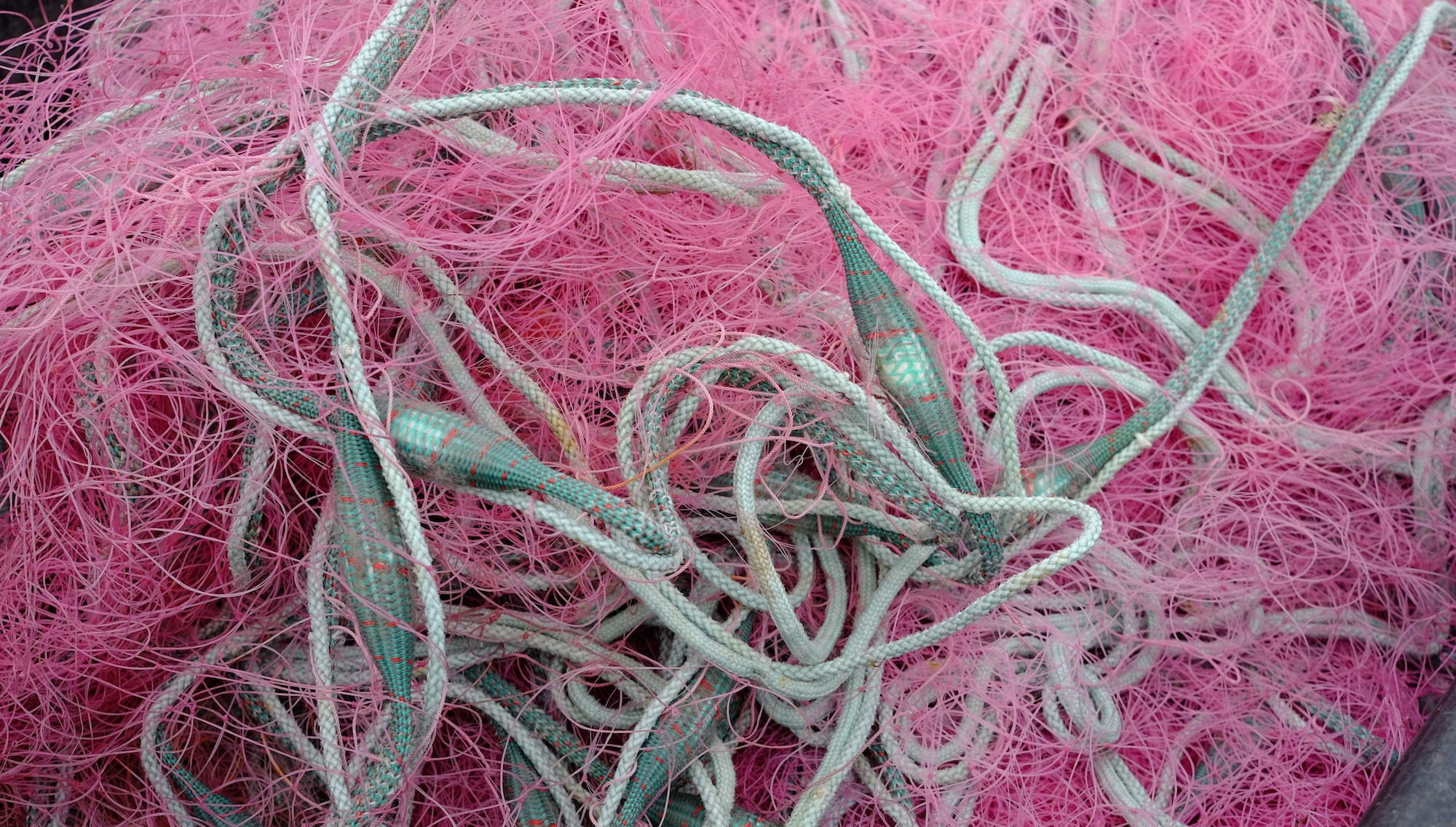Plastic, the size of a virus
Music by Dorian Roy
Anja narrates
Welcome to the Plastisphere. The podcast on plastic, people and the planet. My name is Anja Krieger. In this podcast, I invite you to accompany me while I explore our complex entanglement with plastics, and how we can untangle it. I will bring you the insights of scientists, activists and innovators from the global community working to understand and solve issues of plastic pollution.
One worry for many people is microplastic. Scientists have found it in the stomachs of all kinds of animals, even the ones we eat, like mussels. Salt can also contain plastic, when it’s harvested near the sea. Some of these tiny pieces come from bigger chunks of trash that float in the oceans, which break up over time. Others enter the environment from our bathrooms, when people flush shower gels, peelings or make-up containing plastics down the drain. And washing machines can leak thousands of microfibers from synthetic pants and shirts into the water. Even cars leave microplastic behind, when they race down the streets, and their tires produce a fine dust.
But when plastic breaks up, it doesn’t just stop with microplastic. There are even smaller bits called nanoplastics. In this episode, you’ll get to meet a researcher who’s been studying plastic at this extremely fine level.
These nanoplastics could have fundamental effects on our environment and our bodies, but for a long time scientists weren’t able to detect these very small pieces in the environment – until a team of French researchers came along and found them in the open ocean.
The lead author of this study is chemist Alexandra ter Halle who works at the Paul Sabatier University in Toulouse.
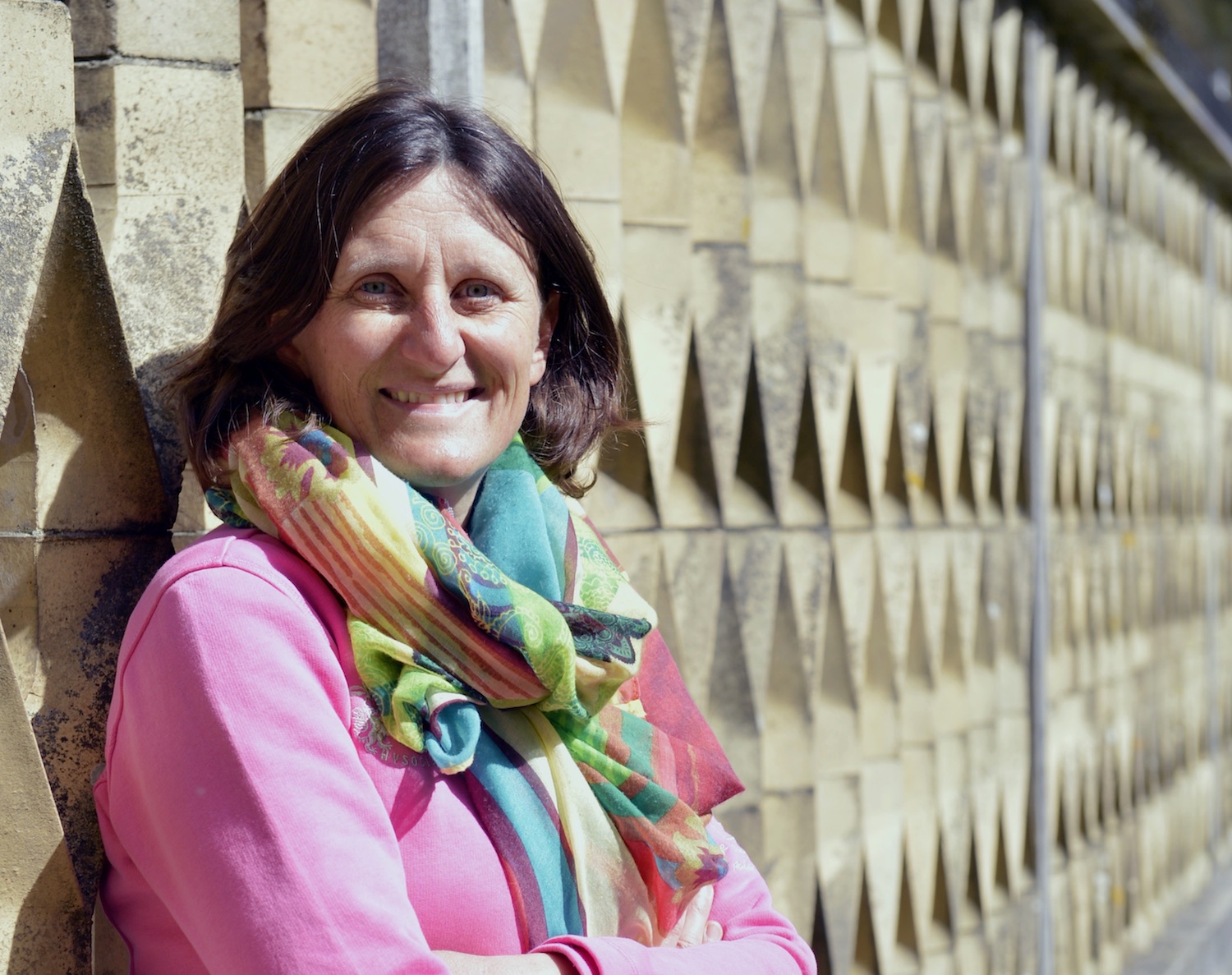
Meeting on street: Bonjour! – Bonjour! Bonjour, Alexandra! Ca va? – Ca va!- On va au laboratoire? Vous voulez…we can speak English! – Yeah, we can speak English!
Anja narrates
I met her at a science conference there recently, and she invited me over to her lab to tell me more about micro and nanoplastic.
Alexandra: So the samples are kept in a refrigerator, and so here there is a little bit of ice. But I will show you the plastic. We call them macrodebris. They are about 10, 20 centimetres big, and you can identify the origin of the object. And many, many of them were packaging objects – container, jars and so on. For example, this green piece of plastic was a piece of coffee in America. Originally it’s a red, bright, and now with the sun, the color passed away and it is just pink.
Anja: Pinkish green, yeah. Did something grow on it?
Alexandra: Ah, yes, we are studying those microorganisms and trying to understand what kind of life is developing on the plastic, and in fact it is very different from the life that lives in the sea. And as a chemist I wanted to understand if there are interactions between the plastic and the organisms – if the kind of plastic is going to modify and change the composition of the biofilm. And we saw that indeed there were some differences, but we are not really able to understand why for the moment.
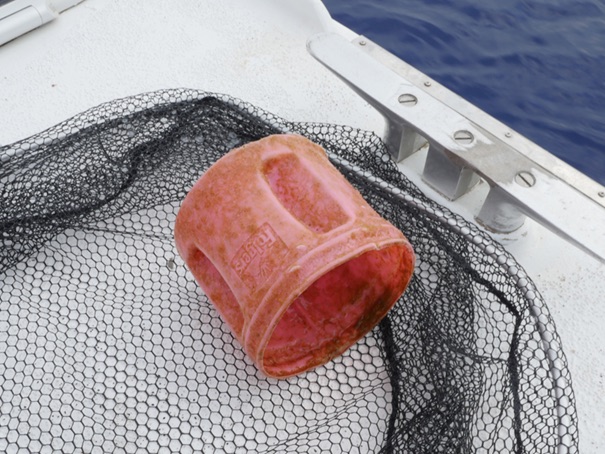
Music by Blue Dot Sessions
Anja narrates
Plastic is a new environment in the open ocean. And organisms are making it their new home. Six years ago, a study by Miriam Goldstein, a graduate student of the Scripps Institution of Oceanography at UC San Diego, found that sea skaters, little insects that live in the marine environment, had started to lay their eggs on the plastic in the subtropical gyre of the North Pacific, and (that they) were now increasing in numbers.
Soon after, Linda Amaral Zettler from the Marine Biological Laboratory in Woods Hole discovered peculiar ecosystems on small pieces of plastics from the North Atlantic. She and her two collaborators found that a vibrant community of microbes was settling on the trash. Some were potential pathogens, while others seemed to be munching away on the plastic. They found that the communities differed a lot depending on geography. Apparently, they can also differ depending on the kind of plastic, and that’s what Alexandra ter Halle is interested in.
Anja: How many kinds of plastics are there in your lab… I mean, do you find?
Alexandra: We usually say that there are six type of plastic sold in the world – polyethylene, high and low density, polystyrene, polyethylene terephthalate, polyvinyl chloride, polypropylene also, polypropylene.
Anja narrates
These are just the most commonly used of the thousands of kinds of plastics that are out there. They come in small pellets and because they can be re-melted, they are called thermoplastics. The Canadian Plastics Association compares them to an ice cube, which you can melt and then cool again. Asking for a precise number of plastic types would be like asking for how many types of bread there are, they write. Each product needs different qualities. So some plastics, for example, are made to keep the air out of food, others to hold heavy weights like a bag and yet others may even stop a bullet.
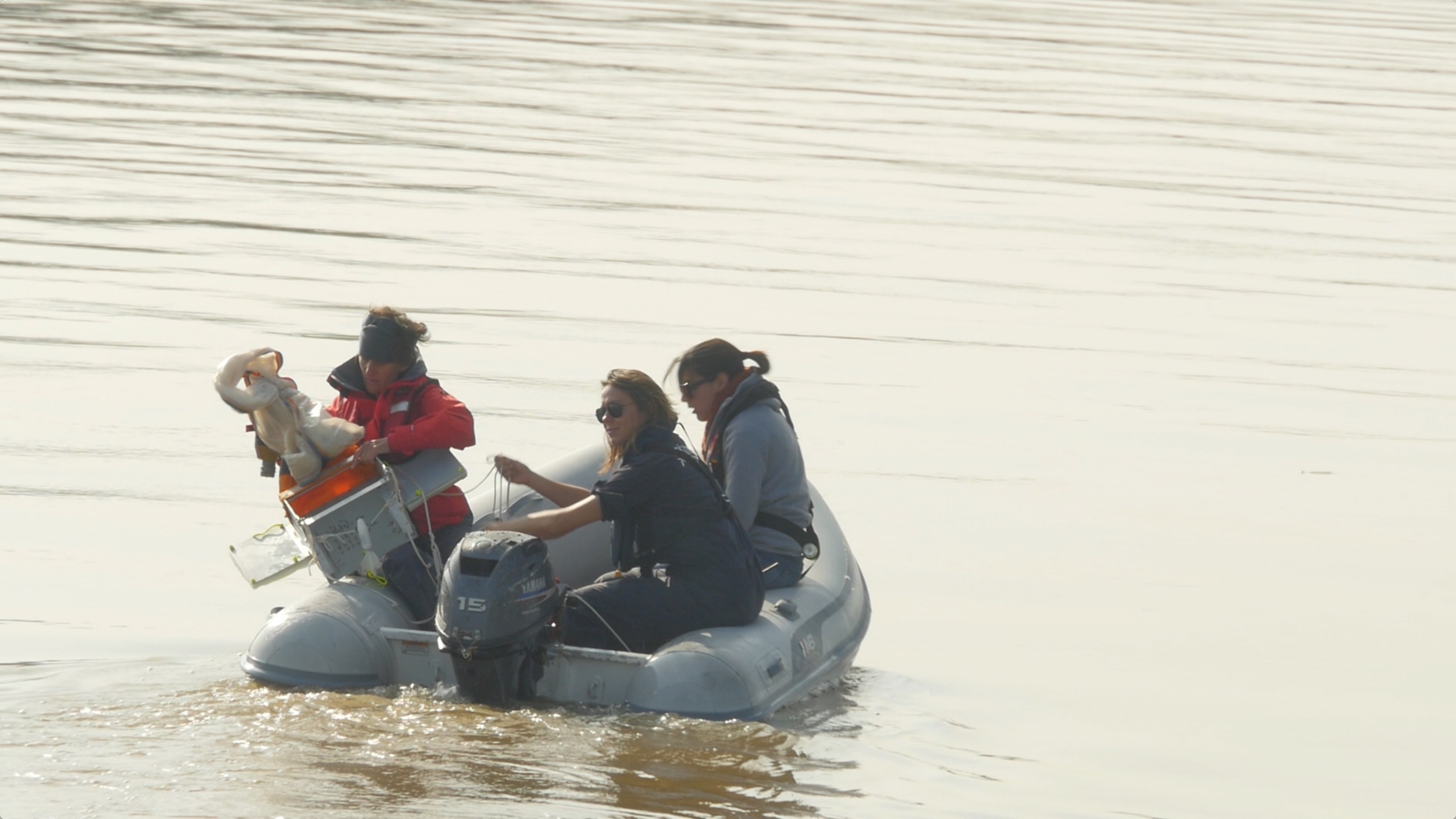
Alexandra:
But the one that you see in the open ocean, afloat, are the ones that are less dense than the seawater. It is polyethylene, polypropylene and expanded polystyrene. But for some kind of reason most of the microplastic in the open ocean are made of polyethylene. There is much less polypropylene and polystyrene than expected. I think it’s because they are breaking down faster than polyethylene.
Anja: How could our listeners identify these kinds of plastics that you just described? There is these numbers, right, these recycling…?
Alexandra: Yes, ah, you’re going to ask me the numbers, I cannot tell you. You know what, the soda bottles are made of polyethylene terephtalate, PET. And then a lot of jar, container for shampoo or fruit juice sometimes or coffee boxes or chocolate boxes are made of polyethylene. And then if the content is a fat, like butter and things like that, it’s going to be polypropylene. So, with a little bit of experience, you understand that there are some specific uses for some specific plastic. And then the polystyrene is a… expanded polystyrene is a lot used for food… for meat or things like that. And when you go eating on the street, most of the time the food is served in polystyrene foams.
Anja narrates
The stuff that Alexandra has stored in her freezer was collected during an expedition called “Le septieme continent”, which translates to “seventh continent”. It refers to the idea that the trash in the oceans is accumulating in large circular currents that exist in all seas, the big gyres. Some years ago, the researchers went out to a region in the North Atlantic called the Sargasso sea to collect samples.
EXPEDITION 7e CONTINENT Atlantique Nord 2015 from 7eContinent on Vimeo.
It’s a large area in the middle of the ocean and one of the most well-researched places in terms of ocean plastics. This is the first place where plastic pieces were found far from land, by two scientists called Carpenter and Smith, in 1972. Of course, it’s not really another continent. It’s bits and pieces of trash floating around, some larger, some smaller.
Alexandra: So these are the easy ones you can see them with the eye and you can hold them in your hands. And then it’s easy to make measurements on them and they help us to understand how the plastic is transformed by UV light, mostly, and then how it is modified by all those exterior stress. And then when you are going to track down the small ones this is going to give us some hints of the structure of those small ones because they are changed from the initial plastic. So I put them back in the fridge. – You’ve got a lot in there – Yes, and I’ve got other fridger in the basement…
Anja: So what do you have in there, frozen fish, plastics, what other surprises? (laughs)
Music by Dorian Roy
Anja narrates
As plastic sweats in the sun and gets beaten by waves, it gets smaller and smaller. The salty water nags on the material, and animals bite their teeth into it. Until it becomes microplastics – defined as plastic smaller than 5 millimeters in size. But the big oceanic gyres are not the only places where microplastics are forming.

Alexandra: So going into the North Atlantic was really important because it’s an emblematic place where plastic is gathering. But now we realize that every place on earth is polluted. Going into the middle of the ocean was very important for me as a chemist because there is not so much organic matter in the open ocean. There is no sand or silt floating in the water. And so when I took my first sample, it was a good first easy start, because there were not interaction with too many organic matter. But we know now that the rivers are the main entrance of the plastic in the ocean and in river it’s much more complicated because there are leaves, dead leaves, and pieces of branch and so many things. So let me show you a sample. It was last week so it’s not very nice to see.
Anja: It looks very… it looks like mud almost.
Alexandra: Yes. Let me get something for you to show you what we are doing as a preparation. At the beginning we’ve got a huge big piece of mud. And at the end we’ve got this small filter and you can see a few particles on top of it. I’m going to open that very quickly because I don’t want any contamination.
Anja: I hardly see anything.
Alexandra: So these are the micro metric particels. So these are the tiny pieces of plastic that are in the river.
Anja narrates
I was looking at a small petry dish with a little pad on it, covered by a sort of substance. But I couldn’t make out individual pieces.
Anja: That is microplastics? That’s very small microplastic.
Alexandra: Yes. It’s a micrometric. This is the size of the diameter of a hair. And then how are we going to analyze that. We are going to use a technique combining microscopy and spectroscopy. So microscopy will give us the size and the shape of their particle, and the spectroscopy will give us the nature of the particle. And we want to be sure that if we are counting the pollution in the river we are not counting sand or organic matter. So by having an analysis of the matter we make sure that every particle we count are made of plastic. And what kind of plastic it is.
Anja: Can I have a look at this petri dish or is it dangerous if I open…do I contaminate it?
Alexandra: Yes! This is another one.
Anja: Ah, on this one I can see them better. They’re like tiny tiny little black… not even dots. It’s like a powder.
Alexandra: Yes. So this plastic on those filters are made of tiny tiny particles of a polyethylene, polypropylene, PVC, PET, polystyrene. And there might be some other type of plastic like paint particles or dust from tires. But those are really difficult to analyze and I’ve still to keep working to be sure how to detect them.
Anja: So this is really the tiny tiny microplastic that you found in…
Alexandra: Yes, river Garonne. The river that passes through Toulouse.
Music by Dorian Roy
Anja narrates:
There are many challenges researchers face when looking at plastic pollution. In the ocean, they get relatively clean samples, but it’s a long and expensive journey. It’s easier to get to the rivers, but there all the samples are completely covered in the other stuff that travels with the stream. It takes them up to 20 steps to clean it. And even then, some organic matter stays in there, so it’s much harder to analyse. For that, they need expensive laboratory equipment that can tell them whether the tiny pieces they are looking at are actually plastic, and what kind.
Anja: So what’s next, once you analyzed it?
Alexandra: So now what you want to understand what’s going on over a year, if there are a period in the year where there are more plastic than other, maybe related to the rain events or something like that. And then I have a collaboration with a biologist specialized in ecology and we are going to study the trophic transfer of the plastic. We are going to look in the macroinvertebrates up to the top predators, the fishes in the river, and we are going to look at all trophic level and see if there is a transfer of plastic in the food web in the river.
Anja: And how are you going to do that?
Alexandra: We gonna now collect those animals and we are going to analyse their gastro-intestinal system.
Anja: What they have in their stomachs and their… and their intestines?
Alexandra: Yes, we are going to do that.
Anja narrates:
This is important: If microplastics are eaten by small animals and those animals are eaten by bigger ones, the food web of the rivers could be infiltrated. The animals who are higher up the food chain would consume the tiny plastic pieces with their food. And together with the plastic, they could consume harmful additives and substances that act like hormones. That could have big effects on ecosystems and is one of the reasons microplastics are so worrisome.
Anja: So are these the smallest ones you find?
Alexandra: No. So those are the micro, and we’ve been tracking the nano that are a thousand times smaller than those ones.
Anja: I guess you can’t show me those?
Alexandra: No, I cannot show you those. So, in 2016, we collected some microplastic from the open ocean and we took them in the lab and we could demonstrate that from micro, nano are forming, from microplastic nanoparticles of plastic are forming – after erosion and stress and things like that. So that was the first step. And then last year in 2017, we published a paper and that was the first demonstration that nanoplastic were present in the natural habitat. So, it was also water collected from the North Atlantic Gyre. We collected seawater. We concentrated this seawater more than a thousand times and then we could detect particles and have an idea of their size. We knew that they were nanometric, in the nanometric range. That’s not enough to assign them as plastic. And then we had the chemical fingerprint of those nanometric object and they were proven to be in plastic. It was a mass spectrometry analysis.
Anja narrates:
Because nanoplastics are so small, the scientists need high-tech methods like these to understand what chemical compounds they are dealing with. And to confirm that what they have found actually contains plastic. To show me what nanoplastics look like, Alexandra ter Halle took me from the lab to her office and showed me a picture pinned to her wall.
Alexandra: The microplasti…the nanoplastic we produced under natural conditions in the lab.
Anja: Is on this poster?
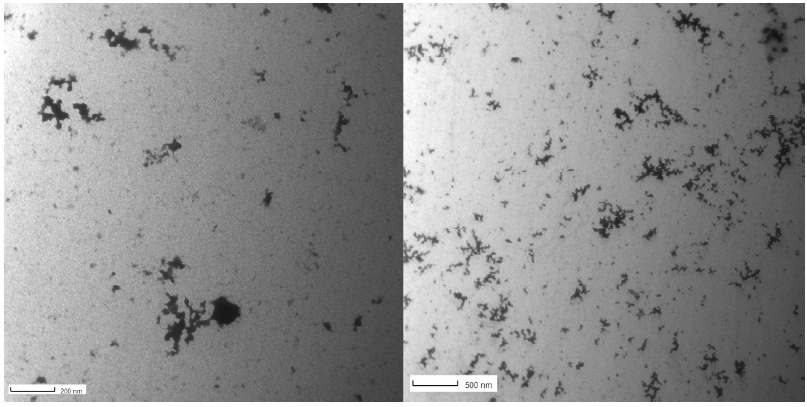
Alexandra: Yes. So this is the microscopic electronic transmission image. Let me show you. You see those small dots. We’ve got some smaller ones and bigger ones in the nanometric range. And they’ve got different kinds of shapes and some are packed together…
Anja: So you say the nanometric range – how small are they, can you compare it to anything in nature?
Alexandra: Viruses? A nanoplastic just big like a virus.
Anja narrates:
If you’d like to take a look at this picture with the nanoplastics, you can find it in the episode transcript on the podcast website (you’re already here ;). Alexandra ter Halle had initially said that these super-tiny particles might be different from the initial plastic material. They might have a different chemistry.
Anja: So, these are still polymers?
Alexandra: You know what, I’m wondering. A polymer, it’s a long chain. It’s a very long molecule of carbon and hydrogen and oxygen and upon weathering and upon UV-light from the sun, this might be broken down into smaller and smaller pieces. So, I’m wondering if the polymer backbone in those nanoplastic is long as the one in the original plastic or if it is shorter, is it oligomers? It is certainly modified from the original plastic.
Anja: And what would that mean? What would the implications be in either case if they are still polymer chains or not anymore?
Alexandra: The implication is important, I think, from a biological point of view. The interaction of a very long molecule or a shorter one with organisms or cells or microorganism is not the same. So, the implications are important. The thing is, now we are doing eco-toxicological evaluation with standards, and we are demonstrating here that the polymer is modified, so the future evaluation must consider these changes. But it is challenging, it is challenging to collect in the natural habitat, those nanoplastic, or to recreate them under laboratory condition. But we are working on that. And it is challenging. So, it will take a few years before we can present some results.
Anja narrates:
It’s really crucial to assess the potential toxicity of these particles to our ecosystems. If there are impacts this might also have consequences for our own health.
Anja: And do we have an idea already of how much nanoplastics is out there in the ocean?
Alexandra: No, so we were able to detect them by mass spectrometry and for the moment we are not already able to quantitate them. So, we don’t know how much there is.
Anja: And if you’re looking at the risks, what is it you’re looking at, what could this mean for the environment and for us?
Alexandra: Well, we are wondering if they can be transferred in the body. There are already some studies that demonstrate that, that were published a few months ago. And there are also published a study that demonstrate that there is a food transfer of those nanoplastic.
Anja: To our food?
Alexandra: It’s a…so the study with the food transfer was done with algae, invertebrates and two species of fish, and they demonstrated that in those four species there is a transfer.
Anja: So the fish eat the, what are the invertebrates?
Alexandra: Yes, and that have been eating the algae that was made in presence of the nanoplastic.
Anja narrates:
This experiment was conducted by Korean researchers and published this January. They subjected green algae to nano-sized polystyrene. They then let small water fleas feed on this algae, which were then again eaten by the fish. The researchers later detected the nanoplastic in the stomachs of the fish. The fish seemed to be affected negatively, as they were less active in the water. The researchers also showed that the nanoplastics can penetrate the embryo walls and were present in the yolk sac of juveniles that had just hatched. Another study by Karin Mattson and colleagues had previously shown that nanoplastics can pass the blood-brain barrier in fish.
Anja: So it could move into the body, up the foodchain, what else?
Alexandra: We are looking if there are some some consequences in the organisms in the… we are doing those eco-toxicological tests with the colleagues in Toulouse in Ecolab, and we are wondering if there might be some genotoxic effects or mortality or change in the behaviour of the animals, we are looking at all those kinds of things.
Anja: So genotoxic, that would mean, it would change the genes… or what would that mean?
Alexandra: They are looking, yes, at the genes of the animals. They have a special animals that if there are some interaction with the DNA that makes some small dots and they can do microscopy and see if there are some genotoxic effect, yes.
Music by Dorian Roy
Anja narrates:
Could this ever-smaller plastic at some point damage the genetic information of cells – and maybe our own bodies? Nanoplastics and their effects are really a new frontier in plastics research. So let’s hope the results come back negative.
Anja: Because you are a chemist and I’ve always been wondering about this: Like what makes plastics special compared to natural polymers. There are also natural polymers, right?
Alexandra: Yes, plastic is special compared to natural polymer is because it can last a long time. So it is not biodegradable. So it can store the food or liquids for a long time. So the persistency of the plastic is very really interesting compared to biopolymers. But I think the solution to the problem is to prevent the plastic to be in the environment. It’s to collect the plastic, it’s to recycle the plastic, it is to stop with the landfills and then there is no more problem.
Anja: Thank you so much for the lab tour, Alexandra ter Halle.
Alexandra: Thank you!
Anja narrates:
And thank you for listening. This was the Plastisphere with environmental chemist Alexandra ter Halle from Toulouse. My name is Anja Krieger and the music was composed by Dorian Roy and Blue Dot Sessions.
My thanks go to Deborah Blum and the Knight Science Journalism Program for bringing me to Toulouse for a fact-checking panel at the Euro Science Open Forum. I also owe huge thanks to fellow producers Ines Blaesius, Tim Howard and Luisa Beck for their feedback on the podcast. And to RiffReporter Joachim Budde for editing the German translation and asking the right tricky questions.
Melanie Bergmann of the Alfred Wegener Institute for Polar and Marine Research tweeted me valuable links to nanoplastic studies, many thanks for that!
I hope you enjoyed this episode. Please consider supporting the production on Patreon or via RiffReporter. If you have any comments or questions, send me a message to mail at anjakrieger dot com. My name is written with a j and a k, so it’s a n j a k r i e g e r. You can also tweet to me @plastispherepod.
Stay tuned for the next episode! Until then – refuse, reduce, repair and recycle. Thank you, bye bye. And Tschüss.
